Duck season is in full swing in Minnesota with a successful season off to a great start. There’s nothing better than heading up north in the fall to view the fall colors and settle in for some epic duck hunting. Of course you can find excellent duck hunting all over the state, not just up north, after all Minnesota is the “Land of 10,000 Lakes”. Whether you are a novice hunter or an experienced veteran, here is everything you need to know about duck hunting season in Minnesota including season dates, bag limits and more!
What Kinds of Ducks Live in Minnesota?
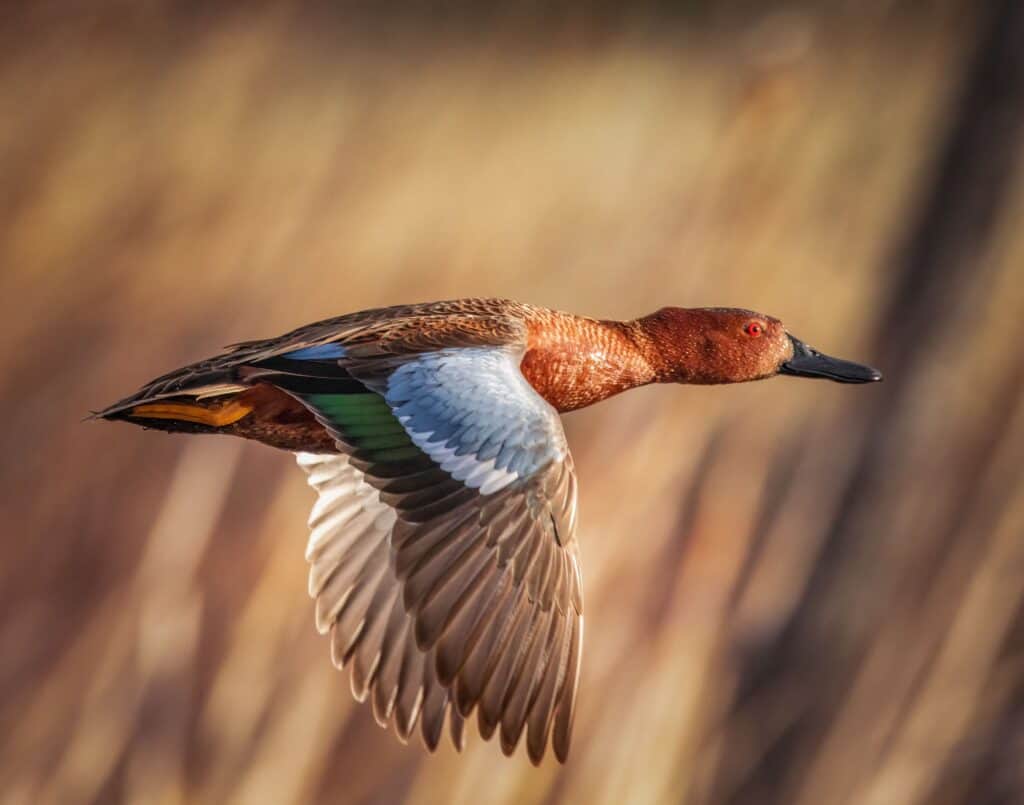
There’s nothing better than heading up north in the fall to view the fall colors and settle in for some epic duck hunting.
©Wirestock Creators/Shutterstock.com
When we talk about duck hunting we are talking about a variety of waterfowl. In Minnesota the main ducks and waterfowl that can be hunted include:
- Teals
- Blue-winged teal
- Green-winged teal
- Cinnamon Teal
- Duck
- Coot
- Mearganser
- Scaup
- Moorhen (gallineul)
- Geese
- Canada
- White fronted
- Brant
- Snow
- Blue Snow
- Ross’s
Where can you Duck Hunt in Minnesota?

You can duck hunt in one of the three designated Zones in Minnesota.
©JROriginal23/Shutterstock.com
You can duck hunt in one of the three designated Zones in Minnesota. The North, Central and South zones are divided to help monitor the migratory patterns of the ducks in each region. You can see a map of the Zones here.
What are the Season Dates?
| Early Teal (Harvest of Blue-winged, Green-winged and Cinnamon teal allowed.) | |
| Zone | Date |
| Statewide | Sept. 3-7 |
| Ducks, coots, mergansers | |
| Zone | Dates |
| North | Sept. 24 – Nov. 22 |
| Central | Sept. 24 – Oct. 2; Oct. 8 – Nov. 27 |
| South | Sept. 24 – Oct. 2; Oct. 8 – Nov. 27 |
| Geese Early Goose – StatewideSept. 3-18 | |
| Zone | Dates |
| North | Sept. 24-Dec. 23 |
| Central | Sept. 24-Oct. 2; Oct. 8-Dec. 28 |
| South | Sept. 24-Oct. 2; Oct. 8-Dec. 28 |
What are the Bag Limits for Duck Hunting in Minnesota?
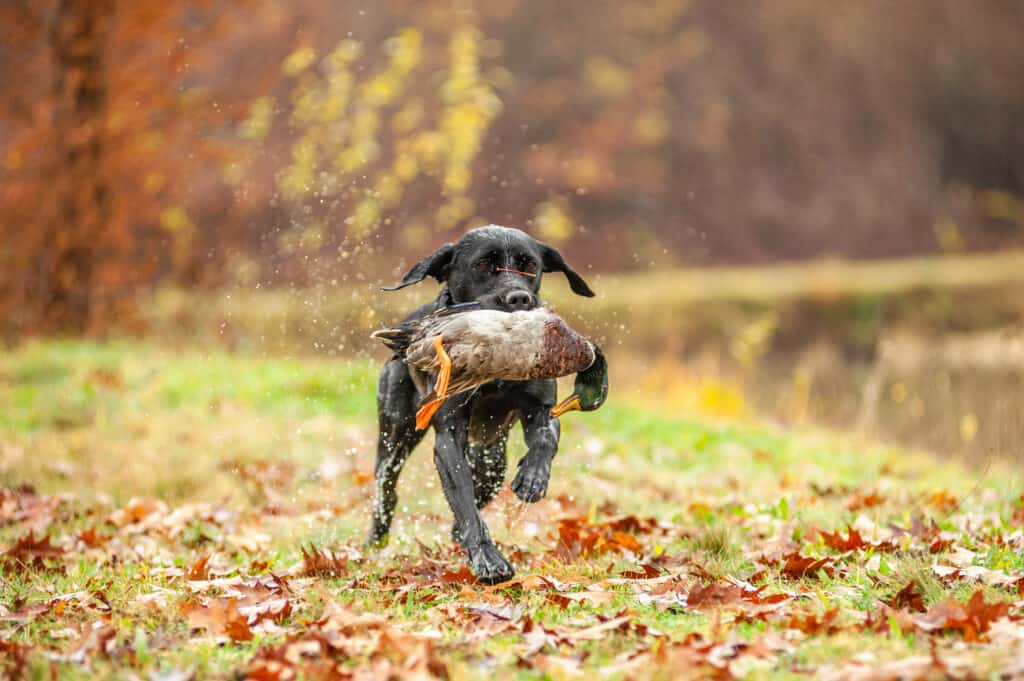
Be sure to keep up with the bag limits and don’t get carried away.
©Anna Pozzi – Zoophotos/Shutterstock.com
6 is the magic number in Minnesota. The combined daily limit for all species, except geese, is 6. Here is how it breaks out per species:
| Species | Daily Limit |
| Blue-winged teal | 6 combined for teals |
| Green-winged teal | 6 combined for teals |
| Cinnamon teal | 6 combined for teals |
| Mallard ducks | 4 (2 hens) |
| Wood duck | 3 |
| Redhead duck | 2 |
| Canvasback | 2 |
| Black duck | 2 |
| Pintail | 1 |
| All other “ducks” | 6 |
| Scaup (Zone opening day to Oct. 13) | 1 |
| Scaup (Oct. 13 to Zone closing day)2Coots & moorhen (gallinule)15Mergansers5 (no more than 2 of which may be hooded mergansers)Geese (Canada, White-fronted, Brant)5 combinedGeese (Snow, Blue snow, Ross’s)20 |
What are the Possession Limits?
The possession limit for migratory birds in Minnesota is three times the daily limit.
What are the Shooting Hours?
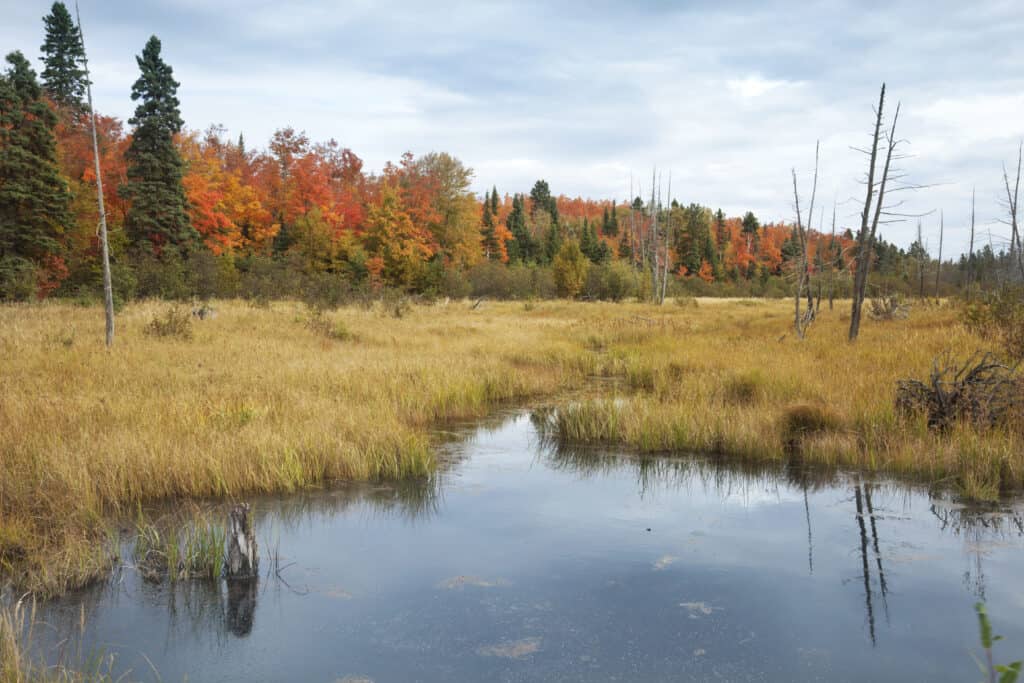
Take time to set out your decoys, set up your blind and be ready to go when the first wave of ducks may arrive.
©Dan Thornberg/Shutterstock.com
The regulations around the hours for shooting are similar across all three zones. Many hunters like to prep and be set up about an hour before regulation hours. Take time to set out your decoys, set up your blind and be ready to go when the first wave of ducks may arrive. Here is a link to the sunrise/sunset times so you can plan ahead: NOAA sunrise and sunset times.
The regulations are that hunting may begin ½ hour before sunrise and continue until sunset. The exception to this is the early teal season (September 3-7) when shooting can begin at sunrise.
Gear Up! What Gear do you Need for Duck Hunting Season in Minnesota?
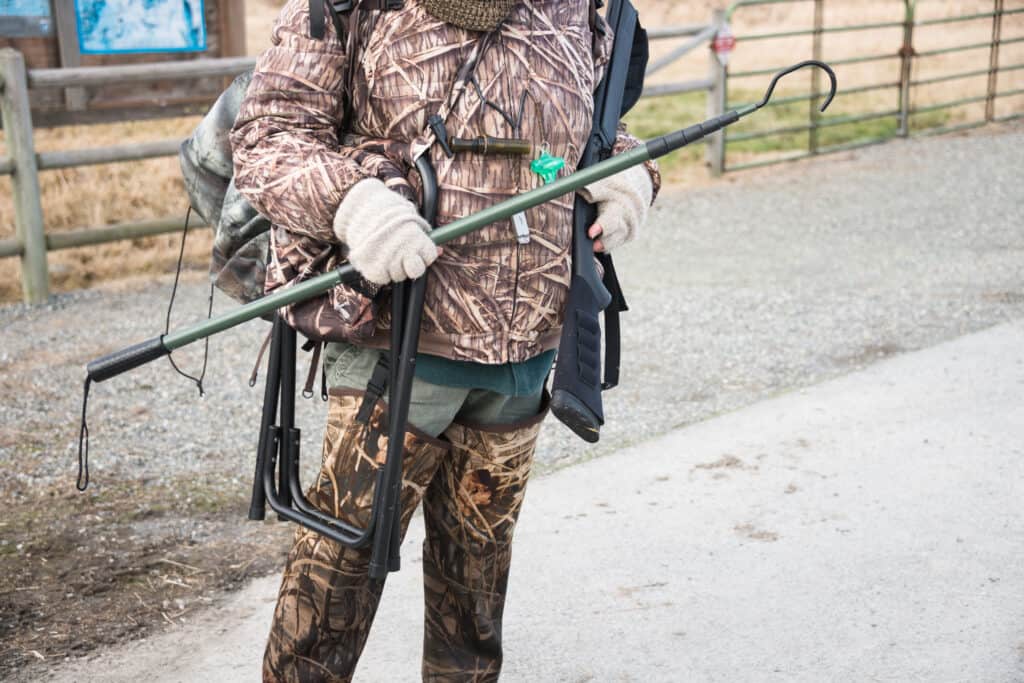
The right gear can make a big difference between a miserable cold, wet, duckless day and a well prepared exciting day of meeting your bag limit.
©Denise Lett/Shutterstock.com
You know duck hunting season in Minnesota is limited so you don’t want to miss an opportunity due to lack of gear or improper planning. If you’ve been invited to tag along on a hunt or you are an experienced hunter there are a few things you need to have to make it a successful hunt.
- Proper gun (example: Escort 12 gauge)
- The right shells (depends on the size of the bird and distance)
- Duck blind: three words…scout it out. Take time to scout the area you plan to hunt so you can learn the rhythm of the birds you are targeting. Choose a spot and set up your blind. If you think it is camouflaged enough, go ahead and add just a little more brush to be sure.
- Decoys: depending on the species you are after but a dozen or so decoys is a good start. Know your species to know if you should have bubblers and mojo’s or if you should have a quiet inviting setting.
- Camo: It is really important to blend in with your surroundings. Everything should be camouflaged to match your blind, including your face. Face paint or a camouflaged gator are essential to blending in.
- Duck callers: If you are targeting one species then you only need one duck caller but many hunters will have a string of callers to adapt to what shows up. Practice your calls and know your waterfowl so you can attract the ducks you want to your location.
- Waders: Be sure to have a sturdy pair of waders for setting the decoys and retrieving your kills.
- Dog: Many duck hunters in Minnesota enjoy hunting with their dogs. The training process and success of having your pup retrieve your kills is a rewarding experience.
- Thermacell: Not on every hunters list, but for the early teal season or for hunting in late September it doesn’t hurt to have a Thermacell mosquito repeller.
Factors for Success
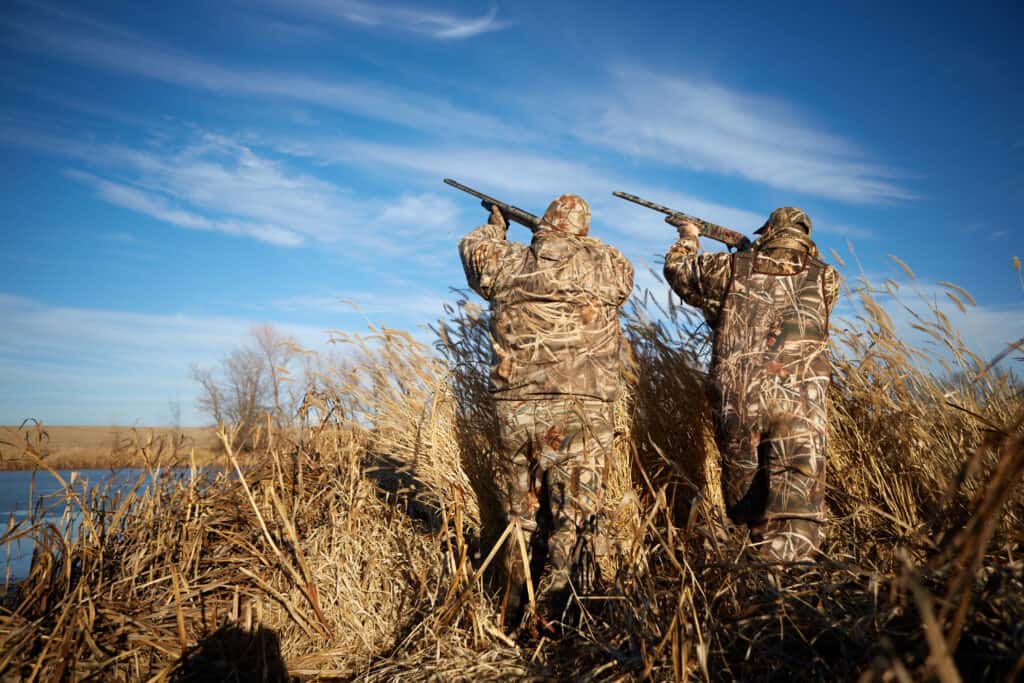
Take the time to scout the area you want to hunt and monitor the movement and rhythms of the waterfowl prior to setting up your blind.
©CLP Media/Shutterstock.com
When planning for the optimal duck hunting trip you can consider a few factors for success. One is the weather. Duck hunters report that wet, cool, overcast days may bring in the most ducks. Depending on the species of duck you are targeting you may want to take into consideration the barometric pressure, temperature and wind speed as well.
One of the best factors for success is scouting. Take the time to scout the area you want to hunt and monitor the movement and rhythms of the waterfowl prior to setting up your blind. Migratory birds patterns are dependent on the weather and a number of factors, so do your homework and watch and learn. This is also a good time to listen carefully to how the ducks communicate so you can replicate their calls. See what they sound like in air, before they land and when they are in the water.
Where are the Best Places to Duck Hunt in Minnesota?
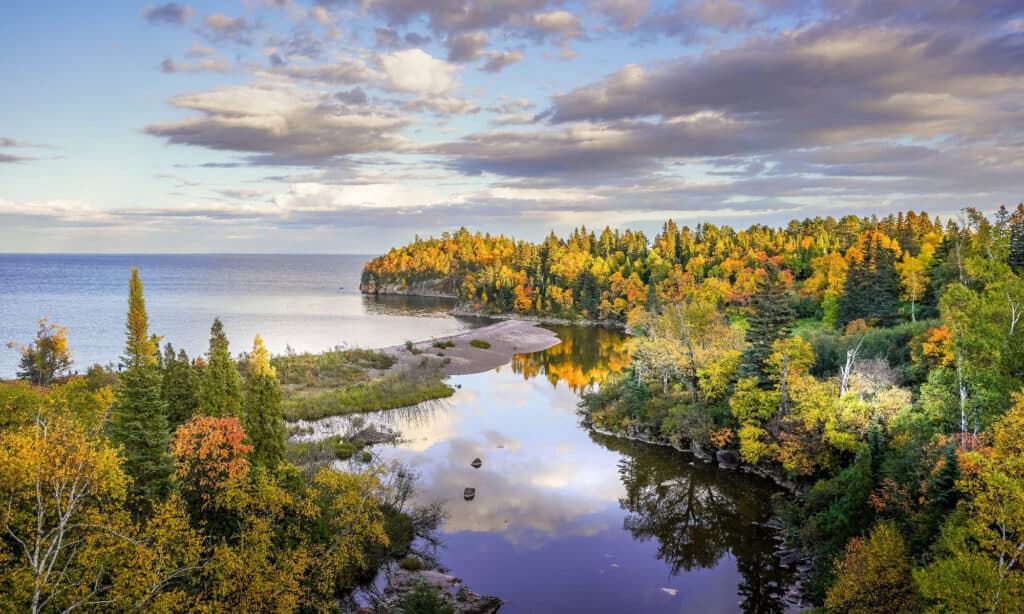
Lake Superior is one of the many lakes you can open water hunt.
©iStock.com/Susan Rydberg
Choosing the right habitat is also an important strategy to a successful hunt. Minnesota has thousands of lakes and you can open water hunt on the following lakes: Lake Pepin, Lake of the Woods, Lake Mille Lacs, and Lake Superior. You can also hunt on the Mississippi River south of Hastings as long as you are 100 feet from the shoreline.
Five of the most common wildlife management areas in Minnesota that monitor the number of waterfowl are:
- Thief Lake WMA
- Sherburne NWR
- Rice Lake NWR
- Carlos Avery WMA
- Lac qui Parle WMA
Meet the Species: 3 of the Most Common Ducks in Minnesota
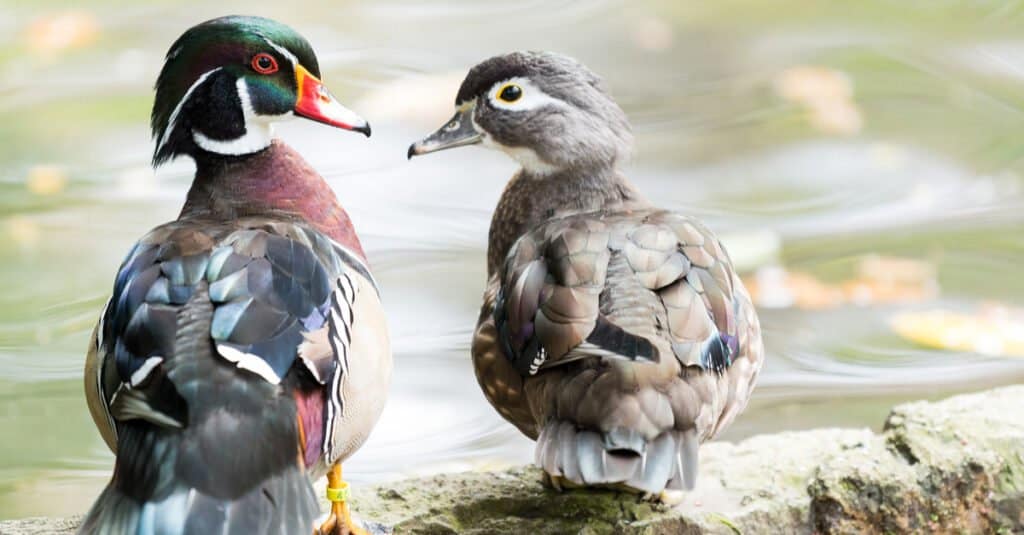
Wood ducks are a more colorful duck with a head that is iridescent green with an orange beak and orange eyes.
©JonVallejoPhotography/Shutterstock.com
1) Teal Ducks: The three kinds of teal ducks that can be hunted in Minnesota are the blue-winged, green-winged and cinnamon. As you can imagine the differences between this species has a lot to do with their coloring.
Blue-winged teals (the males) have a bluish gray head with a vertical white stripe behind their bill. They have cheetah spotted feathers on the front half of their bodies with tail feathers that are black. While in flight you can see a stripe of blue on their wings.
Green-winged teal have a dark brown head and crescent shaped green coloration on their heads. They have a yellowish colored stripe on their tail feathers. Their bodies are a white/black pattern with dark brown feathers on their backs.
Cinnamon teals have a, you guessed it, cinnamon coloration with dark brown feathers and a long wide bill. Their tail feathers are a darker color, black with white trim.
2) Mallard Ducks: Male mallard ducks have an emerald green head and bright yellow bill. They have a white “necklace” that encircles their neck. Their bodies are gray and they have black tail feathers. These are one of the most common ducks in North America.
3) Wood Ducks: Wood ducks are a more colorful duck with a head that is iridescent green with an orange beak and orange eyes. They have a mix of white patterned stripes and markings mixed in with their brown, black and grey feathers.
Be sure to plan ahead for the ultimate duck hunting excursion; know your species, scout your location and have the best gear.
Up Next
- The Absolute Best Camping near Minneapolis
- Land of Lakes: The 20 Largest Lakes in Minnesota
- 10 Stunning Waterfalls in Minnesota
The photo featured at the top of this post is © JROriginal23/Shutterstock.com
Sources
- Minnesota Department of Natural Resources, Available here: https://www.dnr.state.mn.us/hunting/waterfowl/index.html
- Minnesota Department of Natural Resources, Available here: https://www.dnr.state.mn.us/hunting/waterfowl/index.html
- NOAA, Available here: https://gml.noaa.gov/grad/solcalc/sunrise.html
- Minnesota Waterfowl Hunting Regulations, Available here: https://files.dnr.state.mn.us/rlp/regulations/hunting/waterfowl.pdf#page=18
FAQs (Frequently Asked Questions)
Can you duck hunt in Minnesota?
Yes, duck hunting is allowed in Minnesota. Waterfowl hunters 16 and older need to have a license. They also need an official Federal Duck Stamp and HIP certification.
When does duck hunting season start in Minnesota?
The early teal season begins September 3, 2022.
What are the most common ducks in Minnesota?
The most common ducks hunted in Minnesota are the blue-winged-teal, green-winged teal and mallard duck.
What is the bag limit for mallard ducks in Minnesota?
The bag limit for mallard ducks is 4 with a limit of 2 hens.
Thank you for reading! Have some feedback for us? Contact the AZ Animals editorial team.






